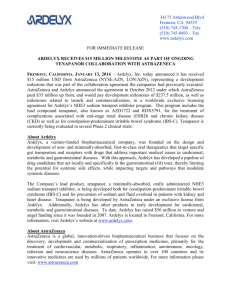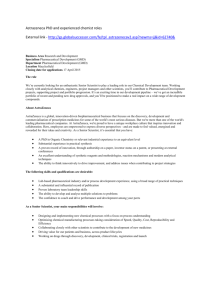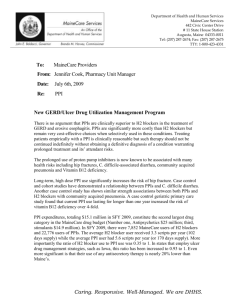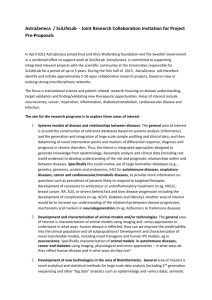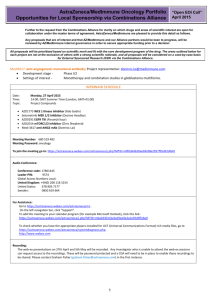Misusing Law and Regulation to Exclude Competitors Reflections on AstraZeneca
advertisement
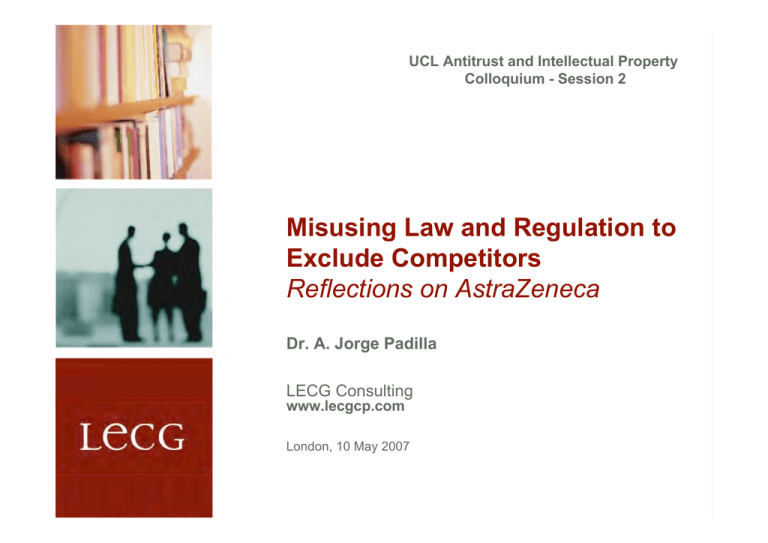
UCL Antitrust and Intellectual Property Colloquium - Session 2 Misusing Law and Regulation to Exclude Competitors Reflections on AstraZeneca Dr. A. Jorge Padilla LECG Consulting www.lecgcp.com London, 10 May 2007 2 AstraZeneca – Overview AstraZeneca (AZ) is a pharmaceutical and healthcare company. In the 1990’s its major revenue source was a medicine called Losec which treats acid-related gastrointestinal diseases. On 12 May 1999 Generics (UK) Limited and Scandinavian Pharmaceuticals Generics AB (both part of Merck Generics) lodged a joint complaint of abuse of a dominant position against AZ. On 15 June 2006 the EC Commission concluded that AZ had abused its dominant position within the meaning of Article 82 EC in two ways: – First, AZ made misleading representations to national patent offices to (a) obtain supplementary protection certificates (patent extensions) that it would not otherwise have obtained, and (b) obtain supplementary protection certificates for longer periods than it would otherwise have obtained. – Second, AZ switched the formulation of Losec from capsules to tablets to delay generic market entry and parallel trade. The Commission imposed a fine of €46,000,000 on AstraZeneca AB and AstraZeneca Plc, jointly and severally liable, and an additional fine of €14,000,000 on AstraZeneca AB. 3 AstraZeneca – Market definition AZ supplies an omeprazole-based medicine marketed as Losec, which is used to treat three acid-related gastrointestinal diseases: peptic ulcers, reflux, and dyspepsia. Losec prevents acid from being pumped into the stomach by a specific enzyme, the proton pump. Losec is a class of medicines known as ‘proton pump inhibitors’ (PPIs). Omeprazole was the first PPI to be launched in the late 1980s. In the early to mid nineties, alternative PPIs became available, whose active substances were lanzoprazole, pantoprazole and rabeprazole. The Commission concluded that the relevant markets were national markets for PPIs. AZ did not dispute the geographic market definition. However, AZ argued that the relevant product market included H2 blockers. H2 blockers, like PPIs, block acid secretion into the stomach. H2 blockers disable some of the cells that stimulate the proton pump, whereas PPIs target the proton pump directly. They are significantly cheaper than PPIs (often less than half the price). PPIs are considered to be superior to H2 blockers in terms of healing rate, symptom relief, eradication rates and the prevention of relapse. They are also seen as providing the only adequate treatment for severe cases of reflux or dyspepsia. 4 AstraZeneca – Market definition AZ claimed that the product market was wider because: – The majority of patients suffering from acid-related gastrointestinal diseases were treated in the primary care sector where PPIs and H2 blockers were seen as substitutes. – Its internal documents at the time of the alleged abuse showed that they considered H2 blockers to be competing products. – A report by IMS Health showed that PPIs and H2 blockers were prescribed to a large cohort of patients on the same medical grounds over the relevant period. – A report by Lexecon, commissioned by AZ, provided an econometric model which estimated the cross-price elasticity of H2 blockers price on Losec’s market share to be 0.22 in Germany and 0.5 in the UK. – Price is not the only relevant factor in assessing market definition for pharmaceuticals and that other factors – such as therapeutic use – should be taken into account. 5 AstraZeneca – Market definition The Commission assessed the product market for each Member State individually and concluded that there was a separate market for PPI in each. The main bases for this conclusion was that: – At the time, pharmacies were not entitled or encouraged to replace prescriptions for PPIs with (cheaper) H2 blockers. – PPIs had a different mode of action to H2 blockers, which explained the perception of their therapeutic superiority. – There was a significant patient population for which only prescription PPIs provided an effective treatment to their acid-related gastrointestinal diseases. – The shift towards PPIs at the expense of H2 blockers was a trend seen across Europe and not inconsistent with a separate PPI market. – Correlation analysis submitted by the complainants showed that the correlation co-efficient between the relative price of PPIs and the relative size of the market for PPIs was positive in 7 out of 8 countries studied, and close to 1 in Germany, Denmark, and the UK. 6 AstraZeneca – Market definition – The Lexecon report presupposed a market for H2 blockers and PPIs, it did not take account of the cellophane fallacy, the time trend was not adequately accounted for, the model was not shown to be robust to autocorrelation and alternative specifications of the model showed the results to be statistically insignificant. – ‘Natural events’ suggested that PPIs and H2 blockers were in separate markets: • The launch of a new PPI medicine in Germany reduced the price of Losec by 16%, but did not significantly affect the price of H2 blockers; • The entry of generic H2 blockers in Germany reduced the price of branded H2 blockers by 40% but did not affect the prices of PPIs; and • The launch of generic PPIs resulted in a 60% fall in Losec sales volumes. – Supply side substitution was not relevant because of the timescales involved in developing and patent protection. 7 AstraZeneca – Dominance The Commission concluded that AZ was dominant in the supply of PPIs in Belgium, Denmark, the Netherlands, UK, Denmark, Germany and Norway, over the period of the alleged abuses. This conclusion was based on the following findings: – High market shares. – Losec was more expensive than other PPIs. – Losec had an incumbency advantage on the PPI market. Doctors’ prescription inertia and brand loyalty. – As well as a substance patent, AZ had formulation patents protecting the capsule formulation of PPI medicines. AZ had brought patent infringement actions against major competitors who had launched alternative PPI capsules (Takeda, Byk Gulden and Eisai). The nature of the settlements with these competitors meant that AZ was in a position to determine the conditions for competitors’ access to the market. – The key decision maker who purchased the medicines did not bear the cost of the decisions. AZ’s argument that the health authorities had buyer power was therefore rejected. 8 AstraZeneca – First abuse AZ had a patent omeprazole which was due to expire on 3 April 1999. AZ’s first market authorisation for Losec was in France in April 1987. As such, the period between the patent being granted and marketed was eight years. AZ could therefore apply for supplementary protection certificates (SPCs) which lasted for a maximum duration of three years. SPCs take effect at the end of the basic patent and last for the equivalent period in which the medicine was patented but not sold, less five years. SPCs are granted for a maximum of five years. In most European countries SPCs can be granted if the first market authorisation of the medicine in any country was granted after 1 January 1982. However, Denmark, Germany, Finland and Norway are exceptions to this rule, and only grant SPCs for a medicine if the first market authorisation of that medicine was granted after 1 January 1988. 9 AstraZeneca – First abuse AZ applied for SPCs in two stages: – In June 1993 it applied for SPCs in seven countries: UK, Netherlands, Luxembourg, Ireland, Germany, Denmark and Belgium; and – In November 1994 it applied for SPCs in Austria, Finland and Norway. In the applications, AZ had to state the date of the first market authorisation for Losec capsules. AZ submitted that the first market authorisation was in Luxembourg on 21 March 1988. Internal documents showed that AZ changed the date of its first market authorisation so that it could obtain SPCs in Germany and Denmark, where the patent needed to have been granted after 1 January 1988. The change in date on the applications also lengthened the period between the patent being granted and marketed by seven months. 10 AstraZeneca – Second abuse In 1998/1999 AZ introduced Losec in a tablet form and subsequently deregistered Losec capsules in Denmark, Finland, Norway, Sweden, Germany, Belgium and Ireland. AZ’s internal documents confirmed the intention of the capsule/tablet switch was to foreclose the markets to generic producers and parallel traders. According to AZ’s internal documents, this strategy was deemed to be successful in Denmark, Sweden, Norway, and Finland. – Impact on generic competition: • Generic drug suppliers also have to apply for market authorisation. They do not have to supply results of clinical trials or tests as they can rely on data provided by the original branded medicine (the ‘reference product’). However, one of the conditions for market authorisation is that the reference product is supplied in the Member State where the generic application is filed. • Generic competition was delayed because generic manufacturers who had prepared generic capsules for sale at the end of the patent no longer had a reference product for their market authorisation applications. 11 AstraZeneca – Second abuse • The deregistration and tablet/capsule switch did not prevent Scandinavian Pharmaceuticals Generics AB from launching generic omeprazole as it had already applied for market authorisations before AZ deregistered the capsules. However, other entrants were not granted market authorisations for over two years following the deregistration. In Denmark, a generic manufacturer was refused market authorisation to supply omeprazole capsules with specific reference to AZ’s deregistration. – Impact on parallel trade: • Parallel trade was prevented because capsules were no longer required in these countries and AZ did not sell tablets in low-price countries which would have enabled arbitration. • Parallel traders can only have import licenses for products which have an existing market authorisation. They play their greatest role before patent expiry which often results in entry of even cheaper generic products. • In Denmark, parallel trade in capsules was completely eliminated. In Sweden the parallel trade licenses for omeprazole capsules were revoked. This decision was later reversed by the Swedish Administrative Court, although parallel import volumes had already fallen sharply. In Norway there was no change to the parallel trade licenses but parallel imports dropped dramatically. 12 AstraZeneca – Harm The Commission found that both of these abuses delayed generic entry and prevented parallel imports in a number of Member States. As generic medicines and parallel imports tend to be significantly cheaper than branded medicines, the Commission concluded that there had been an adverse effect on the national health authorities, and thus the taxpayer, in the Benelux countries, Austria, Denmark, Norway and Sweden. Competition Commissioner Neelie Kroes commented: I fully support the need for innovative products to enjoy strong intellectual property protection so that companies can recoup their R & D expenditure and be rewarded for their innovative efforts. However, it is not for a dominant company but for the legislator to decide which period of protection is adequate. Misleading regulators to gain longer protection acts as a disincentive to innovate and is a serious infringement of EU competition rules. Health care systems throughout Europe rely on generic drugs to keep costs down. Patients benefit from lower prices. By preventing generic competition AstraZeneca kept Losec prices artificially high. Moreover, competition from generic products after a patent has expired itself encourages innovation in pharmaceuticals. Commission Press Release IP/05/737 13 AstraZeneca – Comments Market definition – Commission’s conclusion on market definition appears plausible: (a) natural experiments and (b) time trend – unilateral substitution. – Some of the criticisms on AZ’s position, especially those against the Lexecon report, are exaggerated: • Elasticity estimation in Article 82 cases: the cellophane fallacy. • Assessment of the implications of high cross-elasticity estimates. • Other technical aspects. – What was the relevance of the dispute? • If dominance depends critically on this market definition then I would have expected further analysis. Dominance – Commission’s conclusions on dominance also plausible, though • I find the assessment of competition within the PPI market sparse. • Innovation market approach v. product market approach. • Not sure I understand the Commission’s arguments regarding monopsony power. 14 AstraZeneca – Comments First abuse – Likely anti-competitive effect: • Higher prices and negative impact on sequential innovation? • Monopsony power? – Objective justification: • Lying is not only excusable; it is not only innocent; it is, above all, necessary and unavoidable. Without the ameliorations that it offers, life would become a mere syllogism and hence too metallic to be borne. (Mencken, United States). • A single lie destroys a whole reputation for integrity (Gracian, Spain). • I do not mind lying, but I hate inaccuracy (Butler, Great Britain). • He who is not sure of his memory should not undertake the trade of lying (Montaigne, France). • The most common lie is that which one lies to himself; lying to others is relatively an exception (Nietzsche, Germany). – Compliance implications: • What about lobbying efforts to achieve patent extensions? • What about attempts to define or re-define in broad terms the breadth of patents? • What about patent settlements and reverse payments? 15 AstraZeneca – Comments Second abuse – Likely anti-competitive effect: • Higher prices and negative impact on sequential innovation? • Monopsony power? – Objective justification: • Parallel trade – AG Jacob’s Opinion in Syfait: the specific characteristics of the pharmaceutical industry justify the refusal to supply products for parallel trade. • Generic competition – Is the new replacement product advantageous relative to the replaced product? Are there legitimate reasons why the incumbent would not offer the new and old product, thereby allowing the new product to compete on the merits with generic versions of the original product? Would the same decision have been taken in the absence of generic competition? – Is there useful evidence from other countries? – Is there a special responsibility to promote/facilitate generic competition? 16 AstraZeneca – Harm Misleading regulators to gain longer protection acts as a disincentive to innovate and is a serious infringement of EU competition rules. – Ambiguous? By preventing generic competition AstraZeneca kept Losec prices artificially high. – Maybe. It presumes that generics would have achieved what other PPIs had failed to do. It also assumes no buyer power. Moreover, competition from generic products after a patent has expired itself encourages innovation in pharmaceuticals. – “enforcement authorities cannot confidently presume as a matter of economic theory or experience that more competitors are beneficial or that market power is detrimental for R&D, except in the limited case of merger to monopoly where the evidence supports a moderate presumption of harm.” Katz and Shelanski, “Mergers and Innovation”, ALJ, 2007. 17 AstraZeneca – Harm One Buddhist sutra states: “If you want to understand the causes that existed in the past, look at the results as they are manifested in the present. And if you want to understand what results will be manifested in the future, look at the causes that exist in the present”. Hayek, the prophet of liberalism said: “Freedom granted only when it is known beforehand that its effects will be beneficial is not freedom.” In conclusion, quotes and economists have two things in common: – They can be used to support directly opposing theories. – Please attend my seminar if you want to learn about the second common characteristic. Dr. A. Jorge Padilla LECG Consulting www.lecgcp.com LECG Ltd Davidson Building 5 Southampton Street London WC2E 7HA, UK Tel: +44 20 7632 5000 Fax: +44 20 7632 5050
